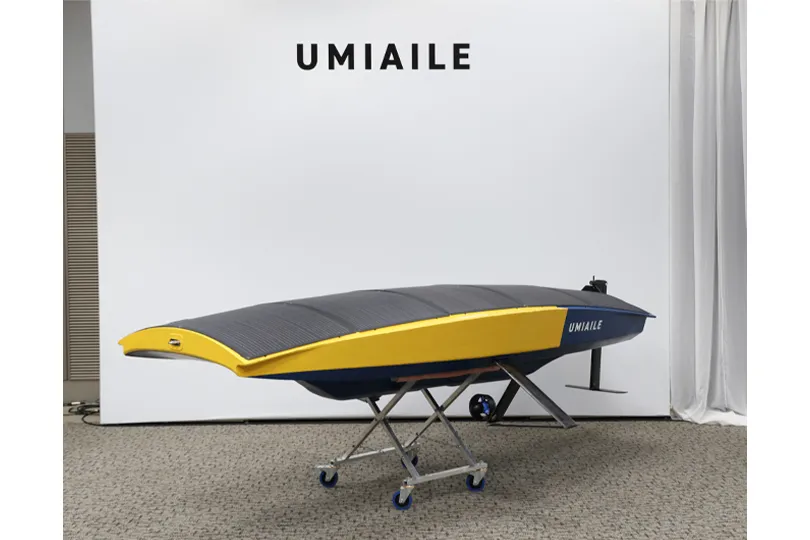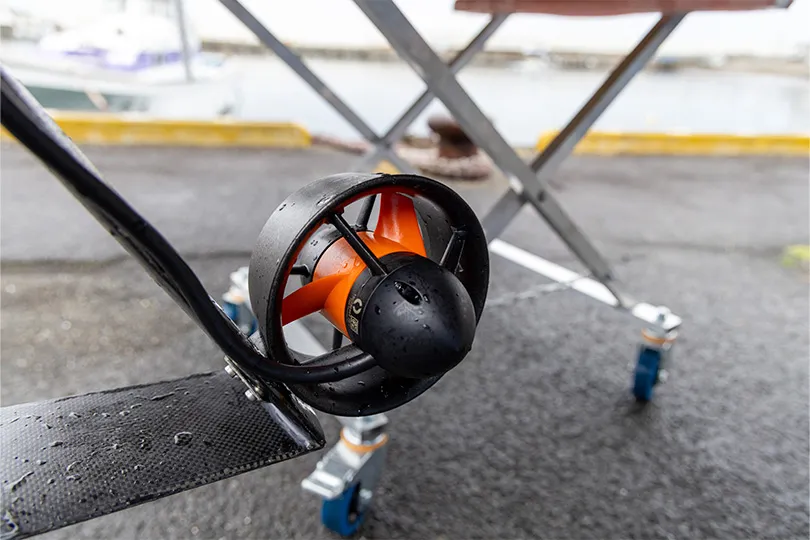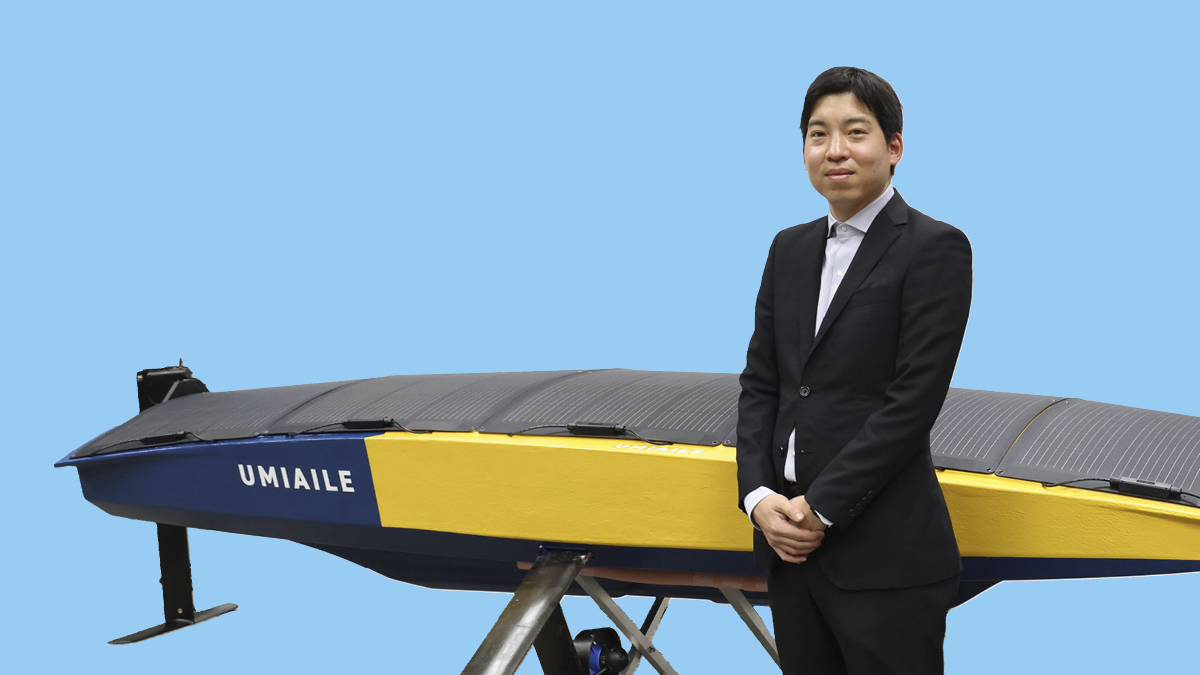POINTWhat you can learn from this article
- UMIAILE is a startup company launched by Honda that aims to solve social issues by “Visualizing the Sea”
- Business model of providing ocean observation data built through Honda’s three realities principle
- UMIALE will contribute to the global environment of 100 years from now through earthquake research and ocean surveys
Small unmanned boat applying aircraft and robotics technologies
 UMIALE ASV small uncrewed boat
UMIALE ASV small uncrewed boat
UMIAILE Co., Ltd., a company aiming to protect a peaceful and prosperous Earth through “visualizing the sea,” was established through Honda’s IGNITION new business creation program. UMIAILE is a startup company launched through Honda to develop and sell the UMIAILE ASV (Autonomous Surface Vehicle) small pilotless boat, and analyze and provide ocean observation data the boat collects. UMIAILE ASV performs ocean observations by remote control via radio communication or by autonomous navigation based on a predefined program.
What does UMIAILE mean by “visualizing the sea?” Founder and CEO Ryosuke Itai explains:
 Ryosuke Itai, CEO of UMIAILE. He participated in birdman contests in his student years.
Ryosuke Itai, CEO of UMIAILE. He participated in birdman contests in his student years.
While being involved in the development and design of robotics and electric mobility hardware at Honda’s R&D facilities, Itai also belongs to the Honda Aviation Research Group, one of the company’s special self-development groups. He conducted research on human-powered and electric airplanes.
The concept of the UMIAILE ASV as a “winged boat” is similar to a drone that flies above the water’s surface. If the hull is lifted above the surface, there is less water resistance and the boat can sail more efficiently, but loses stability. This led us to consider the possibility of applying the attitude control technology which assists vehicle balancing, used in Honda’s UNI-CUB personal mobility vehicle and ASIMO bipedal robot.
 Attitude control technology inspired by UNI-CUB and ASIMO
Attitude control technology inspired by UNI-CUB and ASIMO
After coming up with the idea of applying attitude control technology, I first built a hand-sized scale model, went to Arakawa River early in the morning every day, tried it, worked out its problems in my free time during the day, reworked the model after returning home, and went back to Arakawa River the next morning. This went on for about a year. I don’t know how many times I have seen the sun rise on Arakawa River.
Discovering new business possibilities with Honda’s Three Realities Principle
One of the biggest challenges UMIAILE faced ever since applying to IGNITION and passing the first round of screening has been the development of the business model and its potential.
As we started with a real interest in attitude control technology, we first considered an electric surfboard for leisure in the ocean or lake. As we sorted out information to commercialize the project, we realized this technology and the boat could contribute to improving the efficiency of the fishing industry.
They did not know any fishermen though and were not sure how much demand there would be. Itai then relied on Honda’s Three Realities Principle of practical problem solving based on firsthand experience of the place, product, and circumstance.
First, we decided to go talk to fishermen. I took advantage of various opportunities to obtain as much information as possible, including introductions through acquaintances, participation in hands-on fisherman experience events sponsored by local governments, and helping with aquaculture.
They have gained knowledge through these interviews of issues such as poor fish hauls due to natural disasters and changes in the ecosystem and labor shortages. On the other hand, you found that it is difficult to establish a business in the fishery area due to high manufacturing cost and retail price.
At that time, I had the opportunity to talk to an expert in earthquake research, where I learned that crustal movement observation is useful. What surprised me was that they are not doing research to prevent the next earthquake, but to minimize the damage by precisely observing crustal deformation. They were desperately conducting research to save the world a hundred or two hundred years from now. Once I realized we still do not know anything about the oceans, I began to think that if we accelerate “visualizing the sea,” not only will earthquake research benefit but also blue carbon* observation, weather observation, and efficiency improvement in the fishing industry can advance, and ultimately save the earth.
* Blue carbon: Carbon captured by the world’s coastal and marine ecosystems through photosynthesis and subsequently accumulated on the seafloor and in the deep sea.
Tokio Unno, a co-founder of UMIAILE, says “One day, Itai stopped talking about the fishing industry.” Unno, who joined Honda at the same time as Itai, is CTO of UMIAILE, mainly responsible for software development.
Unno was involved in research on marine engine electrification at Honda, and then moved to an IT company to gain diverse social experience, where he was involved in cutting-edge software technology, including the development of biometric authentication technology using AI.
My fondest memory of working with Itai is when we appeared together on a TV program about manufacturing and worked together to create a robot. I was in charge of the electrics, and Itai handled hardware and overall management. The TV program involved responding to slightly unusual requests from the hosts with technology, and I was very impressed that all our members, including Itai, were able to have fun while working on solutions.
 Tokio Unno, CTO of UMIAILE
Tokio Unno, CTO of UMIAILE
Itai had approached Unno twice to join UMIAILE.
I was looking for someone with strong skills that I did not have, such as electrical component technology, software engineering, and control systems, and I thought that Unno was the only person for the job. More than anything, when we appeared on the TV program together, I was convinced that he was the only person who could take on seemingly reckless challenges while having fun at the same time.
When I first heard about UMIAILE, I turned down the offer because it was time for me to leave Honda, but when I was approached again to apply though the IGNITION program, I had no hesitation. I had always been interested, and was in charge of marine research at Honda, and I am the type of person who likes hands-on development and testing, so the idea of working together to create a technology that had not yet been perfected was very appealing.
Itai has leadership skills and is able to give shape to various ideas without being bound by conventional ideas. I was also strongly impressed by the fact that he always seemed to be enjoying the development process, which brought back memories of when we appeared on the TV program, and I felt that I would be able to overcome difficulties and reckless challenges with him while having fun.
 Itai and Unno became close after working together on a TV program to build a robot
Itai and Unno became close after working together on a TV program to build a robot
Ryohei Nakajima, who had been supporting business development in Honda’s IGNITION department, joined the team as CSO and COO in charge of project management. As the team worked together, one of the difficulties unique to marine projects was the lack of their knowledge and know-how regarding rules and norms, such as who should obtain permits and approvals to conduct verification tests.
By working together with universities and research institutes that have a wealth of expertise in ocean observation, we were able to smooth out management and licensing-related matters, and by building up a track record with the government, we were able to identify more customers. We felt a great sense of progress by organizing the order of our activities.
Aim to continue living on a peaceful and prosperous planet 100 years from now through visualizing the sea
In addition to the three founding members, there were a number of external advisors from IGINITION and collaborators within Honda who provided advice even outside of work. It's not just the presence of these collaborators, Itai noted that Honda has a culture of openness, support, and encouragement for those who take initiatives.
I believe the secrets of enriching the future 100 to 200 years from now may lie dormant in the ocean. We must learn about them, reveal the oceans’ secrets, and make it possible for human beings to continue to live on Earth. With this future in mind, I would like to make this business useful to society.
UMIAILE has its sights on a far away future. Their challenge has just begun.








For those of us living on an island nation, the oceans are familiar, but in fact, research has not progressed, like space research. Precise measurement of the movement of the ocean floor plates would be very useful for earthquake research, and accurate observation of the habitats of seaweed and sea grass that grow on the seabed could provide clues to solving global warming. However, there are only a few research vessels that are capable of oceanographic observation, and the construction of such vessels requires a budget of several tens of billions of yen.
In this regard, the UMIAILE ASV, a small pilotless boat, is inexpensive to manufacture and transport, and yet it is highly mobility. The UMIAILE ASV generates electricity from its onboard solar panels and uses that power to navigate, making it possible to conduct surveys over long periods of time. It can also be used for observations in weather conditions and ocean areas that are difficult for piloted vessels to approach.